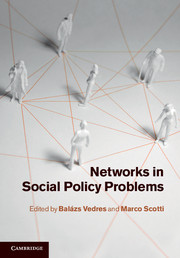Book contents
- Frontmatter
- Contents
- List of contributors
- Acknowledgements
- 1 Introduction
- Part I Information, collaboration, innovation: the creative power of networks
- Part II Influence, capture, corruption: networks perspectives on policy institutions
- Part III Crisis, extinction, world system change: network dynamics on a large scale
- 10 How creative elements help the recovery of networks after crisis: lessons from biology
- 11 Networks and globalization policies
- 12 Network science in ecology: the structure of ecological communities and the biodiversity question
- 13 Supply security in the European natural gas pipeline network
- 14 Conclusions and outlook
- References
- Index
12 - Network science in ecology: the structure of ecological communities and the biodiversity question
from Part III - Crisis, extinction, world system change: network dynamics on a large scale
Published online by Cambridge University Press: 05 September 2012
- Frontmatter
- Contents
- List of contributors
- Acknowledgements
- 1 Introduction
- Part I Information, collaboration, innovation: the creative power of networks
- Part II Influence, capture, corruption: networks perspectives on policy institutions
- Part III Crisis, extinction, world system change: network dynamics on a large scale
- 10 How creative elements help the recovery of networks after crisis: lessons from biology
- 11 Networks and globalization policies
- 12 Network science in ecology: the structure of ecological communities and the biodiversity question
- 13 Supply security in the European natural gas pipeline network
- 14 Conclusions and outlook
- References
- Index
Summary
The study of networks in ecology is rapidly expanding. Although network thinking is by no means new to ecologists, cross-fertilization from other fields, ranging from computer science to sociology, has recently furthered the field significantly. Here we examine some of the applications of network science to ecology, with an emphasis on its potential to contribute to the preservation of biodiversity, an issue that has relevant social and policy implications. Two different forms in which ecological networks may appear are used: food webs and signed digraphs of dynamical systems. In the former, networks represent energy flow transfers from producers to consumers, while in the latter what is depicted is the effect that populations exert on each other.
The main objective is to enlighten as to how applying network science can contribute to some central questions concerning biodiversity, such as the identification of keystone species, the response of population to environmental perturbations, the robustness or inertia of the system to external events in the form of loss of species and links that alter population dynamics.
Biodiversity and the network perspective in ecology
In the last decade biodiversity loss has become of major concern (Loreau et al., 2001; Ceballos and Ehrlich, 2002; Pimm et al., 2006). In the face of this crisis, policies aimed at preserving biodiversity have been called for (Westman, 1990). To shape effective management strategies, a great deal of effort is required in a diversity of fields (Peuhkuri and Jokinen, 1999), prominantly, ecology.
- Type
- Chapter
- Information
- Networks in Social Policy Problems , pp. 220 - 236Publisher: Cambridge University PressPrint publication year: 2012

